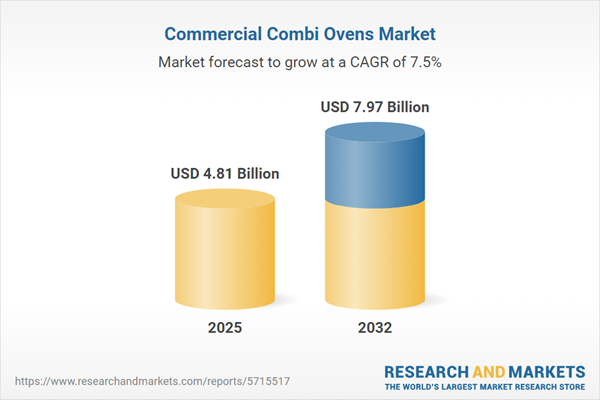Speak directly to the analyst to clarify any post sales queries you may have.
The commercial combi ovens market is transforming global kitchen operations, driven by a growing need for innovative cooking solutions that enhance flexibility and meet evolving industry standards. Decision-makers are rethinking traditional equipment to enable greater adaptability, operational efficiency, and compliance across diverse environments.
Market Snapshot: Commercial Combi Ovens Market Size and Growth
The global commercial combi ovens market is valued at USD 4.47 billion in 2024 and projected to reach USD 4.81 billion by 2025, resulting in a 7.50% compound annual growth rate. Future expansion is strong, with forecasts exceeding USD 7.97 billion by 2032. The primary drivers behind this growth include demand for adaptable cooking solutions across multiple sectors. Organizations are adopting automation and digital connectivity while emphasizing sustainability, positioning the market for competitive advantage. These changes help businesses remain agile in regulatory compliance and menu diversification while supporting robust performance in a crowded landscape.
Scope & Segmentation: Commercial Combi Ovens Market
This report empowers senior leaders to make informed procurement and operational decisions in the commercial combi ovens market through detailed segmentation and industry insights. Critical market segments reflect broad functional, operational, and regional variations:
- End User: Bakeries, patisseries, caterers, educational institutions, healthcare providers, hotels, and restaurants each approach menu diversification, food safety, and process optimization uniquely depending on their service context.
- Mode: Electric and gas ovens allow operators to align purchases with available infrastructure, local energy targets, and sustainability mandates.
- Control Type: Programmable digital panels, touchscreen controls, and manual settings accommodate different workforce skills and facilitate varying levels of kitchen automation.
- Distribution Channel: Direct sales, distributor partnerships, and online procurement platforms enable flexible acquisition to meet diverse operational scenarios.
- Capacity: Compact, medium, and large units support right-sizing according to each organization’s production needs, offering scalability for growth or specialized culinary operations.
- Application: Baking, roasting, steaming, reheating, and sterilizing functions expand menu offerings and assure compliance in high-output settings.
Regional characteristics are integral, as local regulatory requirements, culinary preferences, and differing product rollout strategies distinguish the Americas, EMEA, and Asia-Pacific markets. Manufacturers—such as Rational AG, Electrolux Professional AB, Welbilt Inc, Ali Group S.p.A., Alto-Shaam Inc, MKN GmbH & Co. KG, Henny Penny Corporation, The Middleby Corporation, Fagor Industrial S. Coop, and UNOX S.p.A.—maintain their competitive positions by tailoring products to regional and segment-specific requirements.
Key Takeaways for Senior Decision-Makers
- Hybrid cooking technologies enable organizations to adapt menus swiftly and accommodate changing dietary considerations, resulting in flexible kitchen operations.
- Digital controls and intuitive display interfaces help organizations onboard staff efficiently, lower training investments, and achieve consistent service quality daily.
- Adopting energy-saving features—including advanced insulation and steam recycling—addresses sustainability priorities while supporting reduced long-term utility expenditures.
- Flexible procurement, with multiple purchasing models and channels, ensures organizations can navigate regulatory complexities and diverse site requirements globally.
- Integration of predictive diagnostics and maintenance services assists in aligning kitchen equipment reliability with increasingly dynamic production schedules.
- Offering a range of oven capacities supports scalable production and helps organizations maintain quality standards during expansion or peak demand periods.
Tariff Impact: United States 2025 Adjustments
Adjustments in United States tariffs for 2025 are prompting commercial combi oven suppliers to increase local manufacturing, refine pricing models, and enhance automation. These developments help suppliers stabilize their supply chains and maintain pricing consistency amid changing regulatory demands.
Methodology & Data Sources
This analysis draws on direct executive interviews in foodservice, hospitality, healthcare, and education. Approaches include market assessment, ongoing technology tracking, site-based audits, and value chain analysis, all designed to support well-informed strategic decision-making.
Why This Report Matters
- This report provides actionable technology insights and comprehensive supplier evaluations, supporting efficient procurement strategies across the commercial combi ovens market.
- It outlines compliance and sustainability initiatives, helping organizations meet new regulatory and operational demands.
- The research enables senior leaders to align workforce management and supply chain strategies with the latest kitchen efficiency and adaptability developments.
Conclusion
Strategic investments in kitchen technology and flexible sourcing are essential for organizations facing shifting operational and regulatory demands. Informed approaches to procurement and innovation will help ensure resilient, future-ready culinary operations.
Additional Product Information:
- Purchase of this report includes 1 year online access with quarterly updates.
- This report can be updated on request. Please contact our Customer Experience team using the Ask a Question widget on our website.
Table of Contents
3. Executive Summary
4. Market Overview
7. Cumulative Impact of Artificial Intelligence 2025
Companies Mentioned
The companies profiled in this Commercial Combi Ovens market report include:- Rational AG
- Electrolux Professional AB
- Welbilt Inc
- Ali Group S.p.A
- Alto-Shaam Inc
- MKN GmbH & Co. KG
- Henny Penny Corporation
- The Middleby Corporation
- Fagor Industrial S. Coop
- UNOX S.p.A
Table Information
| Report Attribute | Details |
|---|---|
| No. of Pages | 183 |
| Published | October 2025 |
| Forecast Period | 2025 - 2032 |
| Estimated Market Value ( USD | $ 4.81 Billion |
| Forecasted Market Value ( USD | $ 7.97 Billion |
| Compound Annual Growth Rate | 7.5% |
| Regions Covered | Global |
| No. of Companies Mentioned | 11 |









